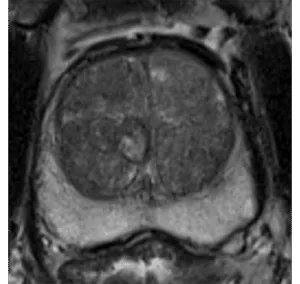Prostate Volume Calculator + PSA Density Calculator
References:
- Stanzione A, Ponsiglione A, Di Fiore GA, et al. Prostate Volume Estimation on MRI: Accuracy and Effects of Ellipsoid and Bullet-Shaped Measurements on PSA Density. Acad Radiol. 2021;28(8):e219-e226. doi:10.1016/j.acra.2020.05.014
- Haas M, Günzel K, Miller K, Hamm B, Cash H, Asbach P. Is the Ellipsoid Formula the New Standard for 3-Tesla MRI Prostate Volume Calculation without Endorectal Coil?. Urol Int. 2017;98(1):49-53. doi:10.1159/000448593
- Littrup PJ, Williams CR, Egglin TK, Kane RA. Determination of prostate volume with transrectal US for cancer screening. Part II. Accuracy of in vitro and in vivo techniques. Radiology. 1991;179(1):49-53. doi:10.1148/radiology.179.1.2006303

Related Calculators:

More About the Prostate Volume Calculator & PSA Density Calculator
The prostate volume calculator and PSA density calculator are essential components in contemporary urologic, radiologic, and oncologic assessment. These tools provide critical, quantitative insights that support clinical decision-making in the management of prostate disorders, particularly in the differentiation between benign and malignant processes. With prostate cancer remaining one of the most prevalent cancers among men globally, accurate evaluation of prostate size and PSA density has become central to early diagnosis, active surveillance, and long-term management.
By translating imaging and laboratory data into meaningful, context-aware metrics, the prostate volume calculator and PSA density calculator improve the clinical interpretability of diagnostic findings. They offer an accessible, structured approach to evaluating the prostate, minimizing uncertainty in cases where PSA alone is insufficient. These calculators are widely applicable across clinical settings, from outpatient consultations to MRI reporting workflows, enhancing consistency and clarity in prostate health evaluation.
Clinical Relevance of Prostate Volume Estimation
The volume of the prostate plays a direct role in numerous aspects of urologic care. It influences the interpretation of PSA values, guides treatment selection for benign prostatic hyperplasia (BPH), and is crucial for surgical and radiation planning. The prostate volume calculator is typically based on imaging measurements obtained through transrectal ultrasound (TRUS) or multiparametric MRI (mpMRI). These modalities allow for accurate volumetric estimation using standard geometric assumptions, most commonly the ellipsoid formula.
In practice, a precise prostate volume measurement can:
- Provide essential data for calculating PSA density.
- Help differentiate between elevated PSA due to BPH versus malignancy.
- Support longitudinal tracking of gland size during medical therapy or observation.
- Inform decisions regarding minimally invasive procedures and surgical feasibility.
Prostate Volume Calculator in BPH and Cancer Management
In BPH management, the prostate volume calculator aids in stratifying patients who may benefit from medications such as 5-alpha-reductase inhibitors, which are more effective in larger glands. Conversely, smaller volumes may support a conservative approach. In prostate cancer, volume affects surgical planning, particularly in robotic-assisted laparoscopic prostatectomy (RALP), and can influence the accuracy of radiation therapy dosimetry.
Understanding PSA Density: Beyond the Raw PSA Level
While total PSA is a common screening biomarker, its specificity is limited. PSA can be elevated for a variety of reasons, including prostatitis, BPH, recent ejaculation, or manipulation. The PSA density calculator enhances the utility of PSA by adjusting for prostate gland size, offering a more individualized assessment of cancer risk.
Calculated as:
PSA Density = PSA (ng/mL) ÷ Prostate Volume (cm³)
This simple formula transforms PSA interpretation by contextualizing it within the anatomical baseline of the patient’s gland. A commonly used threshold is 0.15 ng/mL/cm³. Values above this level may warrant further investigation, while lower values may support observation or delayed intervention.
Benefits of the PSA Density Calculator
- Improves risk stratification in patients with intermediate or borderline PSA levels.
- Supports decisions regarding biopsy versus observation in equivocal cases.
- Enhances clinical assessment in men with large prostates where PSA might be disproportionately elevated.
- Facilitates monitoring in active surveillance programs by tracking PSA changes relative to gland size.
Measurement Techniques Used in Prostate Volume Calculator
The most widely accepted method for estimating prostate size is the ellipsoid formula:
Volume = Width × Height × Length × 0.52
This approach approximates the gland as a three-dimensional ellipsoid and is considered sufficiently accurate for most clinical settings. It is reproducible, quick to apply, and aligns with imaging protocols across TRUS and MRI. In cases of atypical gland shape or pathology, other volumetric models may be used.
Alternative Methods in the Prostate Volume Calculator
- Bullet-Shaped Formula: Adjusts for prostate asymmetry; sometimes used in MRI-based segmentation.
- Manual Segmentation on MRI: Offers high accuracy but is resource-intensive and requires specialized software and expertise.
- 3D Ultrasound Volumetrics: Occasionally used in research or advanced diagnostic workflows.
Integrating Imaging with the PSA Density Calculator
High-resolution mpMRI has become a cornerstone in prostate evaluation. Its ability to visualize zonal anatomy, identify suspicious lesions, and estimate prostate volume makes it highly synergistic with the PSA density calculator. By combining anatomical accuracy with biochemical markers, clinicians can better identify patients who may benefit from biopsy or closer monitoring.
MRI-derived volume measurements tend to correlate well with surgical specimen weights, offering a reliable foundation for PSA density estimation. This integration has become particularly useful in MRI-first diagnostic workflows, where imaging is performed prior to biopsy to help determine its necessity.
Clinical Applications of the PSA Density Calculator
The PSA density calculator is especially helpful in the so-called “gray zone” of PSA values (4–10 ng/mL), where clinical decisions are most uncertain. In such cases, PSA density can tip the balance toward observation or further evaluation. Examples include:
- PSA: 5.2 ng/mL, Volume: 52 cm³ → PSA Density: 0.10 (lower risk)
- PSA: 5.2 ng/mL, Volume: 25 cm³ → PSA Density: 0.21 (elevated risk)
This personalized interpretation often prevents unnecessary biopsies in men with benign glandular enlargement while prompting timely intervention in patients with smaller glands and elevated PSA density.
Guidelines and Evidence Supporting PSA Density Use
Professional societies such as the American Urological Association (AUA) and European Association of Urology (EAU) recommend incorporating PSA density into the decision-making process, particularly for biopsy selection and active surveillance eligibility. The use of the PSA density calculator aligns with these guidelines and supports a more tailored approach to patient care.
In clinical pathways that utilize MRI, PSA density is frequently applied in conjunction with PI-RADS scoring to improve specificity. For example, a PI-RADS 3 lesion with low PSA density may be monitored, whereas elevated PSA density could indicate the need for biopsy despite equivocal imaging.
Limitations and Considerations
While helpful, the accuracy of both the prostate volume calculator and PSA density calculator depends on the precision of underlying measurements. Volume estimations can be affected by image quality, operator skill, and prostate shape. Additionally, PSA levels can be influenced by factors such as recent ejaculation, inflammation, or instrumentation, which must be considered during interpretation.
Neither calculator should be used in isolation; they are most effective when integrated with other diagnostic modalities, clinical context, and shared decision-making between the physician and patient.
Conclusion
The prostate volume calculator and PSA density calculator offer valuable tools for the risk-based assessment of prostate disease. By contextualizing PSA levels within the anatomical framework of the prostate gland, clinicians can make more informed decisions about further imaging, biopsy, treatment, or surveillance. These calculators improve diagnostic clarity, reduce unnecessary interventions, and help align care strategies with each patient's unique clinical profile.
As part of a comprehensive approach to prostate evaluation, these tools contribute meaningfully to precision medicine. Whether managing early detection strategies or refining treatment planning, the careful use of prostate volume and PSA density measurements enhances the accuracy and efficiency of clinical workflows in prostate care.
Ellipsoid Prostate Volume=π/6×DAP×DL×DT
Bullet shaped Prostate Volume=π/4.8×DAP×DL×DT
DAP= Maximum diameter in the Anterior-Posterior plane
DL= Maximum diameter in the Longitudinal plane
DT= Maximum diameter in the Transverse plane





Thank you for this very helpful site.
Saves a lot of my reading time and improved my accuracy
please check Prostate volume calculator. The calculation tool is incorrect.
Thank you for your kind feedback Dr. Doss. The issue has been resolved.